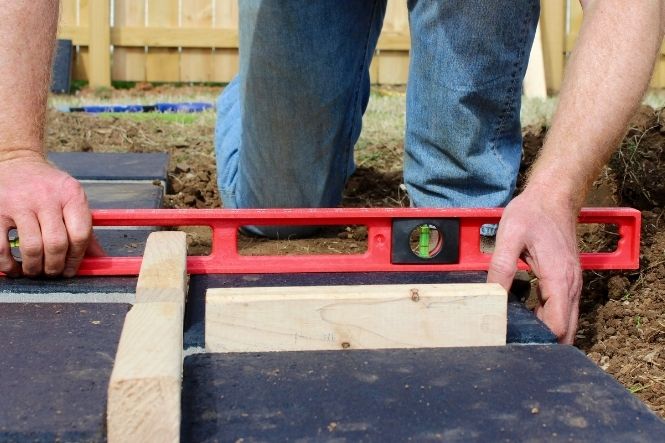Dealing with levels is crucial for a good-looking, long-lasting driveway. Even if the site for a driveway looks flat and level the chances are it won’t turn out to be, once you’ve measured it properly. The reason for this is that the land will have settled over time and there might be slight changes in ground level which weren’t previously noticeable.
A good contractor will ensure that any site has been properly surveyed to check for these variations, but it’s always a good idea to check yourself before you find yourself looking at an uneven drive.
Table of Contents
Flat and Level – Are They the Same?
But first we need to talk about the difference between flat and level and where they are important for driveways. Driveways can be put on plots that aren’t level, i.e. there is a slope. A site may slope in more than one direction and may have different gradients in different places. In fact, even if the site was dead level you would need to build a gentle slope in anyway, to control drainage.
Flat is different; flat is about the evenness of the surface. A driveway can be as flat a as a pancake even if it is on the steepest gradient possible. Unfortunately, just to confuse the issue, if a driveway is completely flat and level, water would sit on it. So you would have to build in a slight curved gradient all along the driveway to encourage water to run off, much like the crown of an ordinary road.
In order to Construct The Drive Properly you will need to build the correct gradient on the site. Now these will be different for every single driveway site because no two sites are the same. But the gradient you make needs to be measured from a level reference point. This article will talk about finding levels and marking them so that the slope can then be measured from those levels.
Start With Your Reference Level
The techniques described here only need a spirit level and a three to four metre long straight timber. First choose a starting point, just above ground level at the highest point on the driveway. Drive a sturdy stake into the ground and mark it with a thick pen. The pen marks show where you will be measuring from.
This is your reference point for all other measurements so make sure it doesn’t move. Then tap similar stakes into the ground along both sides of the driveway site at intervals. The space in between each stake should be just less than your length of timber. Make sure each stake is solid and high enough (judging by sight) to meet your first reference level. Now all you have to do is measure back from your reference point (the stake on the right side of the photo below) and mark a line where each stake meets the reference point.
Transferring the Level
Put a long (over one metre) spirit level on one of the timbers. Most long sprit levels will have holes in them to allow you to screw them to a timber but don’t over-tighten them. You’ll need a helping hand for the next bit. One of you holds one end of the timber at the reference point in line with the mark. The other holds it at the next stake along and marks the level on the stake.
You then move to the next stake down the line, transferring the mark in the same way. Repeat this process for every stake and, in theory, all the marks will be at the same height. Now you have to check all the lines are straight which, of course, they will be if your first stake was level.
Appropriate Levels of Accuracy
Of course, this method is not hugely accurate and the chances are that by the time you come back round to your first reference point the level will be some way from the first mark. It will get slightly less accurate every time it is transferred.
This method is really only good enough for a short driveway as there is some room for error. Professionals won’t like hearing it but on a short driveway you can be millimetres out without it causing massive problems. Inches are another matter.
Improving Accuracy
But you can make it more accurate. Putting out the stakes at distances close enough for diagonal measurements to be taken means that most stakes can be reached from at least two other stakes, providing a cross-check for accuracy.
There are other methods of finding levels that will give higher degrees of accuracy for longer driveways and these are discussed in other articles (read Calculating the Fall on your Driveway and Getting Levels Right on Your Patio).
Conclusion
This method of finding levels is quick, easy and cheap. It just needs patience. Once you know where the reference point for your level is, you can check the slope every time you visit the site but there’s no need to climb up to check it too often.
For these small installations it is not necessary to be accurate to a fraction of an inch. All that matters generally, is getting the correct gradient so that you have the right fall on your driveway.


